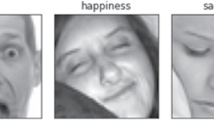Abstract
An information technology is presented with the help of which facial expressions of human emotional states have been analyzed. Facial areas are revealed whose mimic changes are distinctive features for modeling and recognizing visual manifestations of emotional states. Eleven mimic expressions of emotional states are identified whose combinations describe visual manifestations of emotions. The results obtained by the proposed information technology almost coincide with the results obtained by experts.
Similar content being viewed by others
References
Iu. V. Krak, O. V. Barmak, and E. M. Baraban, “Using NURBS-approximation for the construction of a spatial human face model,” Probl. Upravl. Inf., No. 1, 147–156 (2011).
Iu. G. Kryvonos and Iu. V. Krak, “Modeling human hand movements, facial expressions, and articulation to synthesize and visualize gesture information,” Cybernetics and Systems Analysis, 47, No. 4, 501–505 (2011).
Iu. G. Kryvonos, Iu. V. Krak, O. V. Barmak, and D. V. Shkilniuk, “Construction and identification of elements of sign communication,” Cybernetics and Systems Analysis, 49, No. 2, 163–172 (2013).
K. Izard, The Psychology of Emotions [Russian translation], Piter, St. Petersburg (2000).
E. P. Ilyin, Emotions and Feelings [in Russian], Piter, St. Petersburg (2001).
V. O. Leontiev, Classification of Emotions [in Russian], Innovative and Mortgage Center, Odessa (2002).
R. Brunelli and T. Poggio, “Face recognition: Features versus templates,” IEEE Trans. on Pattern Analysis and Machine Intellig., 15, No. 10, 1042–1052 (1993).
A. Martinez and S. Du, “A model of perception of facial expressions of emotion by human: Research overview and perspectives,” J. Machine Learning Res., 13, 1589–1608 (2012).
Yu. G. Krivonos, Yu. V. Krak, O. V. Barmak, et al., “Modeling and analysis of facial expressions of emotions,” Dop. NAN Ukr., No. 12, 51–55 (2008).
M. J. Fehrenbach and S. W. Herring, Illustrated Anatomy of the Head and Neck, 4th Edition, Elsevier. Amsterdam–London–New York (2012).
D. Forsyth and J. Ponce, Computer Vision: A Modern Approach [Russian translation], Publishing House Williams, Moscow (2004).
A. Konushin, “Tracking feature points of a scene,” Computer Graphics and Multimedia, No. 1 (5) (2003), http://cgm.computergraphics.ru/content/view/54.
Pyramidal Implementation of the Lucas–Kanade Feature Tracker Description of the Algorithm, http://robots.stanford.edu/cs223b04/algo_tracking.pdf.
LINQ to SQL, http://msdn.microsoft.com/ru-ru/library/bb386976.aspx (v=vs.110).
OpenCV (Open Source Computer Vision), http://opencv.org/
Author information
Authors and Affiliations
Corresponding author
Additional information
Translated from Kibernetika i Sistemnyi Analiz, No. 1, pp. 30–39, January–February, 2015.
Rights and permissions
About this article
Cite this article
Kryvonos, I.G., Krak, I.V., Barmak, O.V. et al. Information Technology for the Analysis of Mimic Expressions of Human Emotional States. Cybern Syst Anal 51, 25–33 (2015). https://doi.org/10.1007/s10559-015-9693-1
Received:
Published:
Issue Date:
DOI: https://doi.org/10.1007/s10559-015-9693-1




